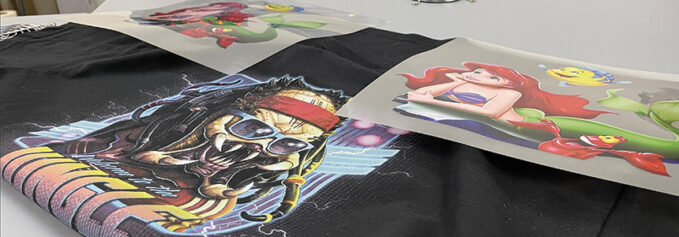
By Melissa Donovan
Direct to film (DTF) printing is popular for hobbyists and smaller businesses with a customer base in online as well as local retail outlets. The technology is attracting wide format sign shops.
There is an ease in which a print service provider (PSP) can create multiple logos, graphics, or small amounts of text with DTF printing. Many times, these same images are found on applications yielded from wide format printers, whether it be banners, floor graphics, or yard signs.
Meeting a need, DTF printers are adapted for sign shops. Most notably, the printable width is expanding—from over 24 to 64 inches in some cases.
What does this mean for direct to garment (DTG) printing? There is certainly still a demand in the wide format sign shop for the technology, but it’s a question of the business model and requirements of the print shop and more importantly its customers.
Above: Output generated from Lawson’s Prestige line of DTF printers.
Complement Wide Format
Interest in DTF printing continues to grow. While many DTF printers are not considered wide format—which Digital Output defines as over 24 inches in width—they still find a home in a wide format print provider’s business.
With DTF, it’s easy enough for a PSP to take their digital files used in display graphics and produce similar graphics on garments or soft goods. “The versatile output of DTF prints allows for the decoration of a variety of media with consistent color output from 100 percent cotton to many synthetic materials,” explains Tim Dinneen, national sales manager, industrial products division, Brother International Corporation.
According to Lily Hunter, product manager, Professional Imaging, Epson America, Inc., “a wide format print provider wants to incorporate DTF into its everyday workflow to increase efficiency and diversify product offerings. DTF can fill the gaps for apparel and textile decoration. When a wide format printer can diversify offerings, there’s opportunity to upsell, as well as the potential to increase customer loyalty and retention. A customer who initially orders a step and repeat for an upcoming trade show can now also place an order for company polos, hats, or tote bags for employees, or to offer as giveaways while onsite at that show.”
As Rob Almstrom, president, American Print Consultants, points out, a PSP’s customers are probably already purchasing customized apparel elsewhere. DTF “is a way to add that offering with a relatively low entry point and without a lot of application knowledge.”
Otherwise, if a PSP isn’t offering these services, they may turn a customer away and miss out on profit. “While these services can be outsourced, depending upon another print provider to get the job done comes with disadvantages, such as the lack of control over quality and turnaround time. Referring the customer to another shop that does DTF printing means not only a loss in profit but also the potential loss of a customer,” explains Mike Davis, application specialist, Roland DGA Corporation.
“Garment decoration is a popular and growing segment of the printing industry. Wide format PSPs already have relationships with their customer base, and those customers are likely ordering printed apparel from someone. Bringing this technology in house allows PSPs to easily add a new revenue stream by supporting the demand from their existing customer base,” suggests Karl Tipre, owner, DTG Connection.
DTF allows wide format PSPs to take on garment decoration at the fraction of the cost and time it takes using traditional methods like screen printing. “An advantage of DTF technology is its ability to streamline the labor-intensive process of garment decoration. Traditional screen printing methods require intricate setup, extensive manual labor, and specialized skills, leading to higher production costs and longer lead times. DTF systems can produce high-quality prints in a fraction of the time required by traditional methods,” says Timothy Mitchell, senior manager, customer experience, Mimaki USA, Inc.
“DTF offers a fairly easy gateway to PSPs that are not offering apparel decoration today. It is an inexpensive and easy to add solution with limited financial risk. Apparel and textile decoration is a great addition to a wide format PSP as in many cases the customers are in need for promotional prints for their business,” notes Sharon Donovich, director of marketing and communications, Kornit Digital.
Vic Nanongkhai, marketing manager, Arcus Printers, agrees. “With the increasing use of textile substrates, DTF provides a straightforward way for PSPs who don’t typically handle textiles to enter this market.”
But Wait…
With interest in DTF printing growing, DTG hardware vendors continue to launch DTF devices into the space. There has been a surge in the introduction of wide format DTF devices—those in widths of 24, 32, and 64 inches—in particular.
The 24-inch width is standard for printers, according to Nanongkhai. “This size enables print shops to easily produce highly popular gang sheets as well as larger format items, such as table skirts. Additionally, the 24-inch width allows for better nesting, which leads to improved substrate utilization and faster overall job printing.”
Almstrom agrees that 24 inches is the standard width for DTF, as it is a good size for production and also for finished goods. He provides examples like gang sheets and large print area applications like hoodies, jackets, or bags.
Dinneen believes the rise in wide format DTF devices is due to “manufacturers using existing technology and then repurposing for DTF or other print methods.”
Many wide format DTF printers, especially earlier models, are converted units. Dedicated solutions are becoming more commonplace. “With reputable manufacturers introducing dedicated solutions, print shops now have access to reliable hardware that enhances workflow and provides peace of mind. As trusted brands enter the market, their loyal customers—many of whom have built businesses around their products—can confidently adopt DTF knowing they have dependable maintenance, warranties, and support,” shares Hunter.
Common applications include apparel customization and personalization, according to Davis. “Another popular use is the production of ready-to-apply transfer graphics that are sold to users who will apply those themselves. This allows a PSP to provide retail and wholesale transfer services.”
With a wide format DTF device, a PSP is able to print over a hundred company logos or pre-ordered designs on one sheet of material, making it highly efficient and versatile, adds Hunter.
“The wider width—especially 64 inches—lends itself to increased throughput, enabling more transfers to be printed across the media. As DTF printing expands beyond transfers for shirts and totes into décor, the extra width is attractive for producing items that were previously unprintable before DTF,” agrees Mitchell.
Whether or not wide format print shops flock to wide format DTF is yet to be determined.
With PSPs constantly looking for ways to achieve more throughput, Davis says “most production-level shops prefer devices that are 24 inches in width or wider for DTF applications because the print area, along with faster speeds, allows for more throughput.”
Wider printers yield less waste for high-volume shops. “Most DTF printers require an inline powder applicator and curing unit. This unit consumes a certain length of DTF film in between print jobs. Therefore, wide format DTF machines are most attractive to high-volume print shops that have less changeover between print runs. Wide format allows for larger prints and larger gang sheets, however, for lower volume shops, a narrower platform will result in less material waste,” says Tipre.
Taylor Landesman, VP, Lawson Screen & Digital Products, Inc., “does not anticipate DTF printers getting wider because of the hassle of dealing with the film width and the heaviness of the roll is not worth the additional space. Wider does not mean faster with DTF.”
“In theory, wider solutions have the possibility to offer increased production, but it is just one small piece of the puzzle to higher volumes. Right now, it does not change the applications it refers to and the width is not connected to the increase of them,” states Kostis Gounaris, business development, Polyprint SA.
Dinneen cautions that prior to purchasing, a PSP should look at how best to meet their customers’ needs—and that might not be through a wide format DTF device. “Wider format DTF printers focus primarily on print output, not necessarily on the workflow. Understanding how the printer manages white ink and the support network behind the product should also be considered.”
What About DTG?
DTG printing is still a viable option when it comes to decorating garments and other soft goods.
Its use depends on business case and applications, according to Donovich. “DTG printing excels in producing high-resolution, detailed prints with vibrant colors. The fine detail and gradient capabilities of DTG are unmatched, especially for intricate designs and photographic images.”
“DTG is better suited for businesses that don’t have a lot of space, do small run print jobs, or have customers interested in a softer finished hand. For wide format print shops, DTG can be attractive for print sampling, because there is less set up and waste than DTF. Then large orders can be transferred to a DTF printer for a production run,” explains Tipre.
According to Hunter, DTG “remains steadfast when it comes to textile printing and is considered and installed by shops looking to offer textile applications. DTG does not require the additional powder application process and remains a preferred method for creating personalized, large t-shirt graphics, and any cotton textile that requires a soft hand feel.”
DTG in the decorated apparel space “allows for more seamless color transitions to the garment as well as generally softer prints. It can be preferred for print on demand shops that do high-volume, completed apparel jobs,” notes Davis.
“There is a place for both, but it depends on the PSP and their needs. DTG has a different hand feel and can achieve more vibrant colors,” adds Almstrom.
Part of DTG’s advantage over DTF has always been the soft hand of the finished garment. However, Landesman says that as DTF matures, the feel is improving, which cuts into DTG’s permanence.
“At Brother, we have found a constant concern from end users who are not happy with the performance of DTF printers in the market due to a wide variety of reasons,” admits Dinneen, which means they look to DTG or hybrid devices to solve any challenges that arise.
Combining the advantages of both DTG and DTF, many PSPs consider adopting a hybrid device into their workflow. “A hybrid printer provides the most versatility in application technology and can open up a larger variety of revenue streams until the business needs justify having a dedicated piece of hardware. A single piece of hardware that offers the best of both worlds,” shares Dinneen.
Delivering DTG and DTF applications, “printers can leverage DTG to print directly to cotton and primarily cotton-blend fabric, as well as print and transfer applications to polyester, cotton/poly blends, and more using DTF, which presents expansion opportunities,” agrees Hunter.
However, Davis says hybrid printers aren’t necessarily ideal for production print shops, “as they require more hands-on use from the operator and don’t feed to a take-up reel.”
Mitchell also feels a hybrid device might not be the best choice. “Hybrid devices still depend on having a shaker as part of the workflow, so it makes more sense to just switch to a DTF-committed device. Many hybrid models are not geared toward the self-contained shaker systems preferred for operator safety.”
In the end, it is about the services the company provides and what its clients are demanding, suggests Gounaris. Hybrid systems are a good starting solution, but a company that has high productions of DTF should end up having a dedicated DTF roll-to-roll system.
Worth Considering
A DTF, DTG, or a hybrid device is worth a look. To learn more about this topic, visit digitaloutput.net to view our most recent webinar.
May2025, Digital Output


